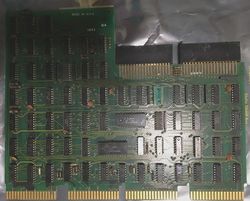Able UNIVERTER
The UNIVERTER is a device which can 'translate' a QBUS into a UNIBUS. This is possible because the high level semantics of the two busses are roughly identical (e.g. in interrupts, DMA, etc); only the low-level details differ. (E.g. the UNIBUS carries addresses and data on separate lines, whereas the QBUS carries them both on a set of shared lines.)
The UNIVERTER was a product of the Able Computer company; from the part number, likely their first product.
Physically, the UNIVERTER is a quad-width PCB that plugs into a quad slot on a QBUS backplane. A dual-width connector along the back edge of the card is the UNIBUS; a standard BC11A UNIBUS cable plugs in there.
The UNIVERTER requires that the bus arbiter, and the interrupt-fielding processor, be on the QBUS. The UNIVERTER does not have to be at the end of the QBUS; i.e. cards can be plugged into the QBUS after the UNIVERTER, but their grant priority will be lower than any UNIBUS devices. Memory can be on either bus.
The UNIVERTER contains several registers which can be used to control optional settings for several fine details of the translator.
